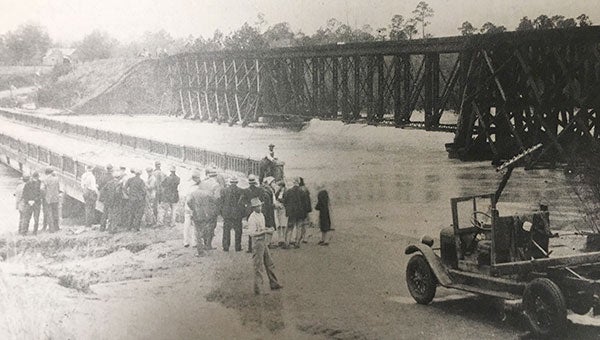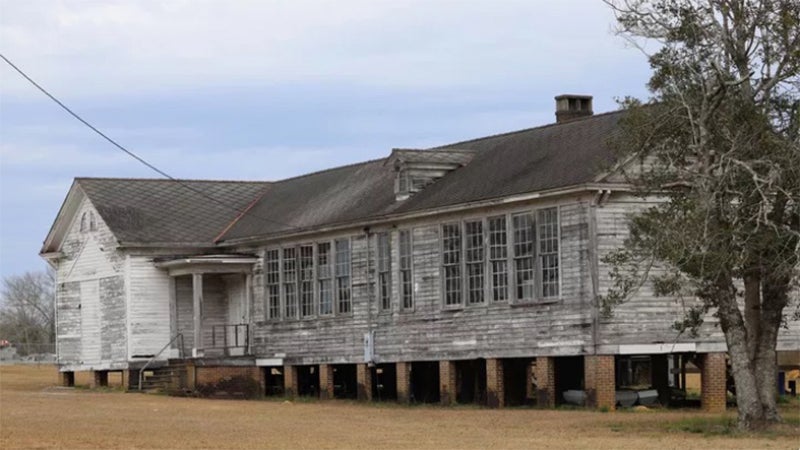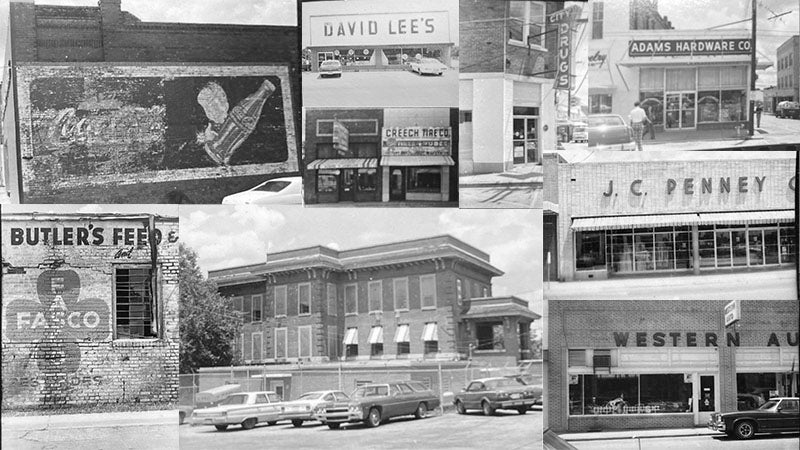Remember When: Dam broke 90 years ago
Published 2:39 am Saturday, March 16, 2019

- Scene of the 1929 Flood at Gantt just before the Dam broke.
“How high’s the water, Mama? Five feet high and rising. How high’s the water, Papa? Five feet high and rising.” These lyrics from Johnny Cash’s song hits close to home when I think about one of the worst storms recorded by old timers, a disaster that was in 1929, 90 years ago this week of March 2019.
In the Historical Edition of The Opp News, Robert D. Burgess wrote, “It began raining continuously on Monday, March 10, 1929. By Tuesday night, the streams were flooding. Power plants at River Falls, Point A, and Gantt where Andalusia, Opp, and several other towns and cities received their electrical power were flooded. Turbines and generators at these hydroelectric plants were stilled. All homes and business establishments were in the dark.”
“Water washed over bridges and highways. Up and down these streams, residents were forced to leave their homes. Many of them lost livestock, feed stuffs, and home furnishings in the swift waters.”
“The town of River Falls was inundated and its occupants were evacuated. The highest points in that area that had never been flooded before were several feet under water. The spillways of the two power plants had blown out from the water pressure.”
“The hardest hit was Elba in Coffee County. The flash flood of the Pea River caused residents to leave their homes without extra clothing and run to higher grounds.”
“All nearby communities sent all the boats, motors, and equipment they had to the stricken area. Andalusia people who had boats were active in rescuing people who had climbed trees remaining there over night until being rescued by passing boats. One or two planes were in use in spotting people on roofs.”
“Twenty-five inches of rain had fallen within the first days of February and March which had soaked the ground. Twelve inches fell with a day and night, March 12 and 13.”
“The Gantt Dam was built with a spillway controlling the water. The fast rushing water carrying logs and other timbers along with it pressed so strongly against the spillway and with water spilling over the dirt wings of the dam, something had to give. The spillways and the dirt wings went out at about the same time throwing a high sheet of gushing water into Point A Lake. It was then only a matter of time before the dirt wings of Point A Dam were blown out sending all the surplus water into the lowlands for miles flooding River Falls and the communities for miles down the valleys.”
From the “Heritage of Covington County, Alabama,” 2003 edition, there are several accounts of the Flood of 1929.
“River Falls remained a “Saw Mill” community until the mill, the Horse Shoe Lumber Company, ceased operation. For many years, the Horse Shoe Lumber Company established in 1898 was River Falls, and River Falls was the Horse Shoe Lumber Company.”
“Few residents of the town were not employed by the company in some capacity. The majority lived in houses rented from the company.”
“The mill was destroyed when the power company dams broke. The damage was irreparable, and the decision was made not to rebuild the mill. With jobs gone, the people had no choice but to leave. The lumber company began selling its property. Most of the houses that remained standing after the flood were torn down and moved away or used for rebuilding. However, there still remain at least two or three homes that were lived in during that time.”
River Falls was initially incorporated in 1902. It was reincorporated in 1935 and today is a thriving place to live with a mayor and council, churches, businesses, post office, and police/fire department.
There is an historic marker near the former site of the Horse Shoe Lumber Company on the corner of Hwy. 84 W. and County Road 107. The Conecuh River Bridge has been named the E. L. More Bridge after the principal owner of the mill and the power company.
Mr. Livingfield More of Nashville, son of the late Mr. E. L. More, has visited River Falls numerous times in recent years where his mother and father spent many happy days in their stately home.
An old account of the flood written by George Clauson Thomasson is intriguing. He was at home on his farm when the rain began, and he watched nervously as the waters began to rise. Soon his neighbors came to his house since their home was on lower ground. During the night, George got up from his bed to empty the pans that were catching water drippings. When he raised the window to throw the water out, he heard water hit water. About that time a bolt of lightning lit up the sky, and he saw that the water was almost over the bee hives he had under a peach tree. He later learned that the dams had burst turning water loose on the nearby settlements.
Neighbors were soon seen coming their way in boats. The women were taken out to the barn so they could get up in the loft. After the men nearly fell into a hole in the back porch, it was decided that the women would stay in the house until daybreak. The men managed to get the stock out of the barn. The stock swam out and were immediately caught in the current and swept toward the river, their heads bobbing up and down. Somehow a neighbor saw them, rounded them up, and saved them until the flood waters receded.
Soon after daybreak, the boats came and took everyone to higher ground. George Thomasson lost everything he had in the ’29 flood. His home had to be rebuilt and the land was not suitable for farming for a long time. He eventually lost the land when he was unable to pay the taxes. This story was remembered by his son Marvin Clinton Thomasson.
One story in this writer’s family goes like this – After the flood, Mr. Charlie Brunson, owner of the Brunson Bakery in downtown Andalusia would wade out in a shallow place at River Falls and hand over boxes of bread to Mr. Charlie Sellers, owner of the Sellers Grocery in Red Level. This was very much appreciated by the people of Red Level.
During the flash flood in Elba, Pope Gordon Mathis and his wife Amanda Borom Mathis of Samson were in the courthouse at Elba. The water rose quickly. They and other people in the courthouse downstairs had to rush upstairs where they eventually got rescued by boat. At that time like many other residents of various communities, they moved to Andalusia near relatives to start over and live out the rest of their lives. They (“Mama and Papa Mathis”) were the parents of Foye Mathis Brunson and the great grandparents of this writer. They are buried in the northwest corner of Magnolia Cemetery in Andalusia.
A story that Grandmother Foye told her grandchildren long time ago as she was rocking the babies to sleep went like this – “It was raining and raining. The mother didn’t know what she was going to do, because the water was getting higher and her little girl couldn’t swim. So she put her in a big wash tub and let her float down the river, because she loved her so much!”
I am sure that that was just one of the many touching stories from the Elba Flood of ’29.
Other floods have come since the big Flood of 1929 over 90 years ago. Many new improvements have been established in connection with weather predicting, communication, and engineering techniques of the waterways and dams. We can REMEMBER WHEN Covington County and South Alabama suffered this great loss as we continue to preserve the local history. Do visit the Three Notch Museum to see the pictures of the Horse Shoe Lumber Company and River Falls in that vintage era.
Sue Bass Wilson, AHS Class of 1965, and long-time member of the Covington Historical Society can be reached at suebwilson47@gmail.com.





